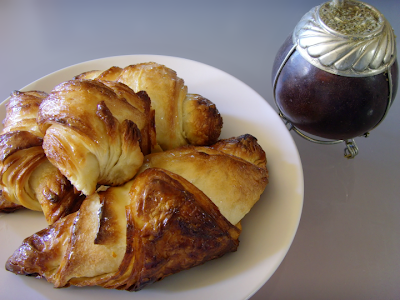Sunday, November 28, 2010
Argentina - Medialunas and Yerba Mate
Background
Argentine cuisine is a blend of French, Spanish, Italian, and Andean influences. This split of European and native influences is found in the differences between the cities and rural areas.
I found lots of information on Argentine cuisine is and its regional variations. All of the books basically mention breakfast as “minimal,” which I interpret as very simple. Looking online I learned that breakfast is either bread covered with dulce de leche, or medialunas, a croissant-shaped pastry. I chose to make medialunas because I wanted to try a variation on the croissant. The drink is either cafe con leche or a tea made from the leaves of the yerba mate plant called mate. Yerba mate is traditionally served from a hollowed gourd, which we conveniently had in the apartment.
Recipe
For this weeks recipe we refer you to the blog of an American ex-patriate living in Necochea, Argentina, who did a wonderful job describing the process. I had to make a substitution for the yeast. Her recipe uses 0.9 oz of fresh yeast which expires quickly because the yeast is active when purchased. We do not bake enough to keep this on hand so I used a substitution of 1½ packages of active dry yeast. Another issue created by this substitution is the need of warm water to activate the yeast. I heated up the milk used in the recipe to serve this purpose. We also chose to put the vanilla extract in the glaze and not in the dough.
Yerba Mate Video
Results and Discussion
The medialunas came out great despite some reservations about the dough I will discuss later. They smelled fantastic while baking and bled butter as they puffed and browned. The vanilla sugar glaze added a nice texture and sweetness. While they were flaky on the outside, the inside felt meatier and solid—a nice contrast.
I was not a fan of the yerba mate. It was bitter and very overpowering. The taste changed with each sip as continued to steep and preferred the earlier sips to the later ones. In the second brewing of the leaves the bitterness was greatly reduced but still pretty strong. Some people add sugar to help with this problem but we were drinking it out of a gourd my mother-in-law gave my wife after her trip to Argentina and putting sugar into these is ill-advised. I should also mention that the bombilla conducts heat so sip carefully if it has been sitting in the water for a long time.
I was initially concerned because the dough was very dry. I checked this against the croissant recipe we used for France and based on the ratios the dryness seemed reasonable. With a dryer dough, cold rising, and my impatience to let the dough get up to room temperature, working the dough was difficult. Kitty came up with a good solution to this on the final turn and I wrapped the dough in a damp warm rag for 10 minutes. Letting the dough rest for an hour outside the fridge in the morning reduced this problem.
I was also nagged by a feeling that the yeast had not fully activated and that this inhibited the rising. I saw the yeast bubbling in the milk before I added it to the mixture so I know it activated.
I would also like to compare the writing of the recipe in this breakfast to the French croissant. This recipe was much more free form in its approach giving the essential guidelines but allowing the cook to shape and size the final item. The French recipe was much more highly detailed with exact dimensions and more information about resting times and other details. It was a gift to a cook trying something intimidating for the first time. The medialunas recipe was great for a second pass at this type of pastry because more awareness of basic techniques are placed on the cook. It demonstrates the importance of understanding why something is done versus following instructions.
Labels:
beverages,
pastry,
South America
Subscribe to:
Post Comments (Atom)

No comments:
Post a Comment